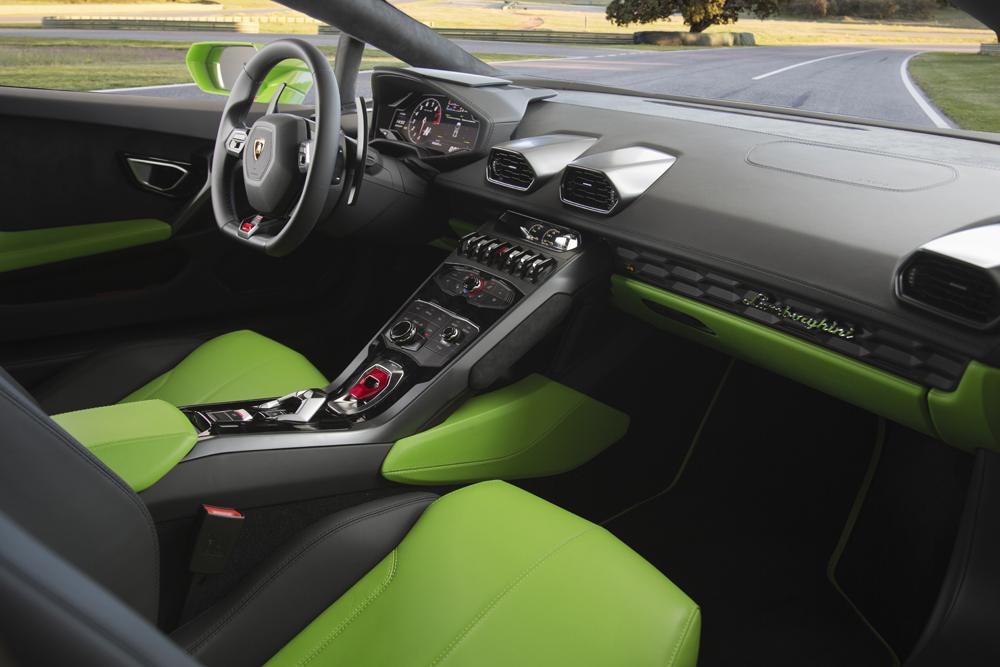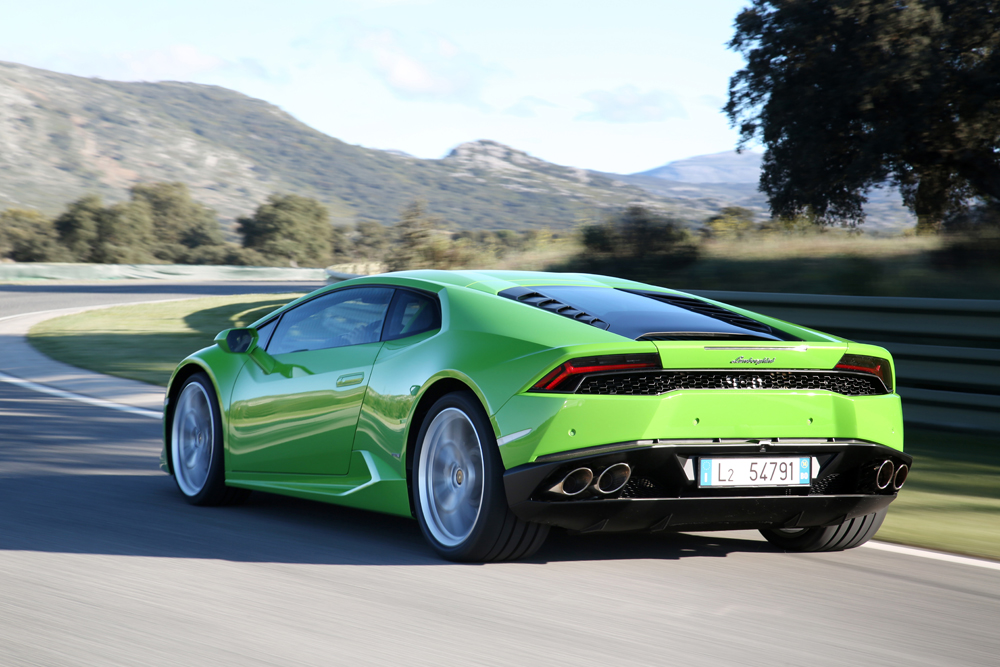First Drive review: 2014 Lamborghini Huracán LP 610-4
Fighter pilots, beware: it’ll waft your socks off
WHY IS the arrival of the Lamborghini Huracán so keenly awaited by car enthusiasts? One reason is that it’s long overdue. The car’s predecessor — the Gallardo — was launched 11 years ago and went through three generations and more than 30 variants in that time without really changing.
Another reason is that the Ferrari 458 has opened up such a decisive lead over its Italian rival that it has taken the sport out of a once-delicious contest.
But perhaps most important, it’s whispered that the Huracán may be the most advanced “affordable” supercar yet devised. Its lightweight body is made from a composite of aluminium and carbon fibre; it has all-wheel drive for a better blast-off, whereas the 458 is rear-wheel drive only; and in place of dials it has a digital display.
You’ll forgive me, then, for my sense of trepidation as I sink into its low-slung seat, the expectations of colleagues and readers weighing heavy on my shoulders.
Search for and buy a used Lamborghini on driving.co.uk
Flipping up the red guard that shields the starter button makes me feel like Maverick, the fighter pilot played by Tom Cruise in the 1980s blockbuster with the annoyingly catchy theme tune. It suggests, with a pleasing sense of mischief, that Lamborghini aims to blow Ferrari, McLaren and Porsche into tiny pieces of aluminium and carbon fibre.
Time to fly into the danger zone. As I strap myself in, I recall why this car is so important to Lamborghini. The Gallardo was the most successful model in the company’s history, with more than 14,000 sold. That may not sound much, but consider this: the Lamborghini factory in Sant’Agata, near Bologna, has built just 30,000 cars — in total.
Flipping up the red guard that shields the starter button makes me feel like Maverick, the fighter pilot played by Tom Cruise in the 1980s blockbuster. Time to fly into the danger zone.
On paper the Huracán does not stray far from the winning formula of its predecessor — a bedroom-wall-poster supercar that could have flowed only from the pen of a top Italian designer or the crayon of an eight-year-old. Its £186,000 price, though, is significantly higher than the £110,000-odd the Gallardo cost when it arrived in 2003.
Inside the car, things have changed. For a start, it feels less claustrophobic, thanks to its low centre tunnel. And while the Gallardo was criticised for using parts from the spares bin of VW, its parent company, the Huracan’s interior looks thoroughly bespoke. The digital display can be tailored to your needs. It can, for example, show a rev counter while you scream round a track, or a sat nav screen for cruising the autostrada.

Controls for the lights and wipers are on the steering wheel, as in the 458, and the three driving modes (Strada, Sport and Corsa ) are operated by a red switch at the bottom of the wheel.
It can feel a little cluttered when you’re fumbling for the gear paddles behind the wheel, and the near-horizontal windscreen pillars make the Lambo less car-park-friendly than the Ferrari.
For now, though, I’m sticking to the racetrack. The engine ignites with a satisfying howl and the moment of truth arrives. So, its straight into Corsa to do battle with the twists and turns of Spain’s celebrated Ascari track.
As I roar towards the first bend, the seven-speed dual-clutch gearbox grabs second gear in less time than it takes to blink. On a hot racetrack, four-wheel drive can work to the driver’s advantage and disadvantage, for while it increases grip, it can also take away some of the fun associated with an out-and-out sports car. Even in Corsa mode, which eases off the electronic stability control and makes everything harder, faster and louder, the Huracán’s chassis feels as if it’s tuned to understeer.
That’s not to say the Huracán won’t have its driver grinning like Berlusconi at a bunga-bunga party. It will. The roar of the V10 is glorious, and fearsome acceleration combined with the regulation carbon-ceramic brakes allow it to safely deliver astonishing turns of speed.
The Huracán will have its driver grinning like Berlusconi at a bunga-bunga party
Yet there is a slight feeling that the car has been tamed — as if by being more competent and controlled, the raging bull is less likely to gore its driver. It’s understandable that Lamborghini should want it this way. It’s nice to arrive home safe and sound in your precious, near-£190,000 supercar, rather than have it transported back on a flatbed truck with a corner or two missing. Lamborghini is looking for quick growth, and by widening the appeal of its bestseller it is more likely to find it.
The Huracán is undeniably a vast improvement on its predecessor. The transmission can be left in automatic or you can shift gears like Lewis Hamilton by snapping the paddles. It puts the old “robotised” manual gearbox of the Gallardo to shame.
The engine is derived from the 5.2-litre V10 that powered both the Gallardo and the Audi R8, but with heavy modifications of its top end and exhaust. It now produces a thunderous 602bhp (or 610PS, hence the “LP 610” in the designation) and 413 lb ft of torque — enough to propel the car to 62mph in a mere 3.2 seconds and to a claimed top speed of 202mph.

The company says 70% of that torque is there from just 1000rpm, and the glorious engine note is now accompanied by a barrage of explosions from the exhaust each time the transmission shifts up or down.
The Huracán’s chassis, which will be shared with the next Audi R8, is almost as strong and rigid as a pure carbon-fibre tub, but at far less expense.
If there’s any car that should leave you starstruck, it’s a Lamborghini, and as this one pulled up at our hotel it drew the kind of crowd you could normally attract only by throwing €100 notes in the air. But as for the most important test of them all, does it make you want to lower the windows and drive through every tunnel and underpass within 50 miles? Yes, of course it does.
And yet, despite the drama of its looks and the thunder of the V10, there is a lingering sense that Lamborghini has pulled its punches just a little bit.
There will be more hardcore versions of this car to come — notably a Superleggera. Stephan Winkelmann, the head of Lamborghini, won’t be drawn on when that (and a spyder ) will go into production.“They were in the plan from the beginning,” was all he’d say, with a wink.
Verdict ★★★★☆
2014 Lamborghini Huracán specifications
Lamborghini Huracán rivals
- Ferrari 458 Italia, £178,526
For Revving the V8 to 9,000rpm, poised handling, elegant styling Against No longer the latest must-have thing, tacky Ferrari merchandising
Search for used Ferraris on driving.co.uk
- Aston Martin V12 Vantage S, £138,000
For Fabulous-sounding V12 engine, handling inspires confidence, looks great Against Dated interior with confusing switchgear, automated manual gearbox
Search for used Aston Martins on driving.co.uk
Search for and buy a used Lamborghini on driving.co.uk
In the tyre tracks of giants
350GT (1964-6)
It doesn’t look like a Lamborghini as we think of the cars today, but this first model set the company on a path that would lead it to take on Ferrari. With a V12 engine producing 320bhp, the 350GT could get to 60mph from rest in 6.7 seconds and reach a top speed of more than 150mph.
Miura (1966-72)
The fastest production car in the world (172mph) when launched in 1966, the Miura set the template for all Lambos since: mid-engined and rear-wheel-drive with uncompromising performance. The Miura is still best remembered for its role in the opening sequence of The Italian Job.
Espada (1968-78)
Not the most attractive Lambo, the Espada was nevertheless the marque’s bestseller. The four-seat grand tourer came with a big 4-litre V12 engine (at a time when fuel economy wasn’t measured by the factory) and could be ordered as an automatic — quite a novelty at the time.
Countach (1974-89)
Admit it: you had a poster on your bedroom wall of a barely clad woman draped across the Countach. The ultimate bad boy of supercars, it was the first production car designed to do 200mph, but it fell foul of US emissions legislation — which served only to increase its appeal to enthusiasts.
Murcielago (2001-10)
After years of financial woe and no new models, the Murcielago was the first new Lamborghini introduced under Audi’s ownership. With a top speed of 209mph, all-wheel drive and a screaming 661bhp engine, it was an emphatic statement that Lamborghini was back, and meant business.




